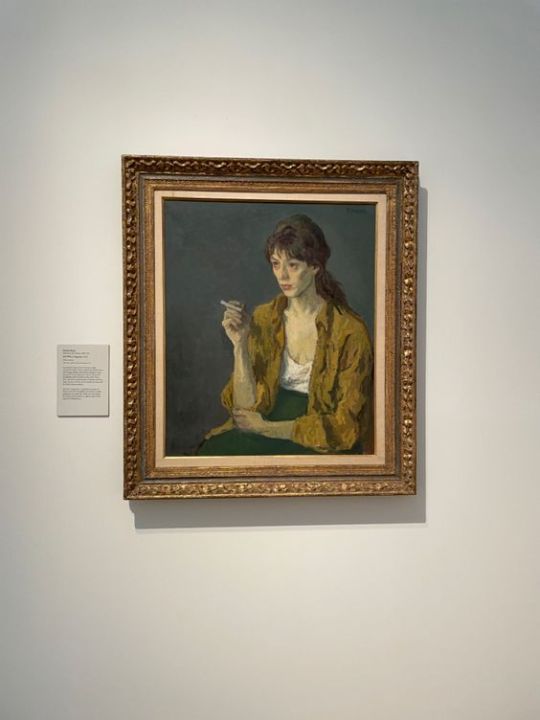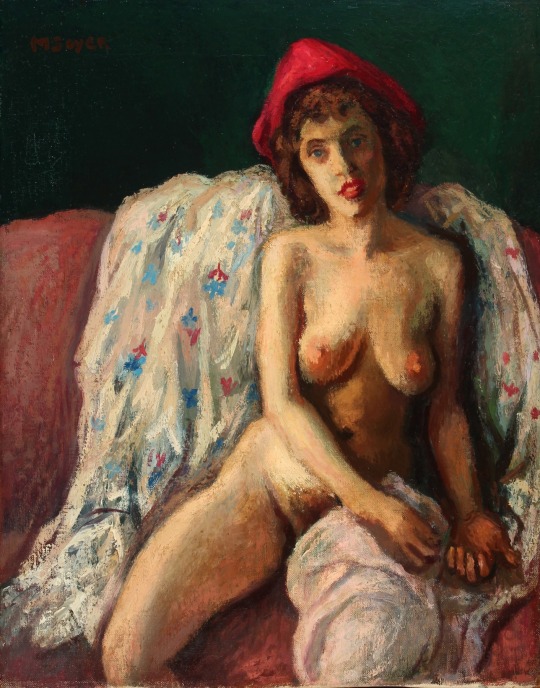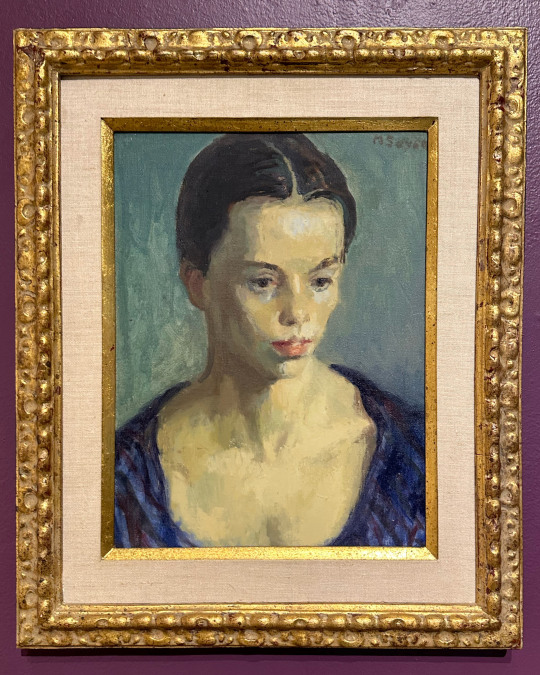#Moses soyer
Explore tagged Tumblr posts
Text

Moses Soyer (American,1899-1974)
Girl in a red skirt
oil on canvas
170 notes
·
View notes
Text

Girl With a Cigarette, Moses Soyer 1968
#art#classical art#art academia#moses soyer#girl with a cigarette#dark academia#chaotic academia#light academia#dark academia moodboard#chaotic aesthetic#literature#poem#romantic academia#classic academia#art history#fine art
155 notes
·
View notes
Text

Dancers at rest, 1960 - by Moses Soyer (1899 - 1974), American
91 notes
·
View notes
Text
Moses Soyer. Girl With A Cigarette, 1968.

#traditional drawing#art#drawing#painting#traditional art#Moses soyer#Portland museum of art#portland#oil on canvas#oil painting
18 notes
·
View notes
Photo

The Red Hat - Moses Soyer , n/d.
American , 1899 - 1974
Oil on canvas , 18 x 14 in.
84 notes
·
View notes
Text

Moses Soyer A Woman Sewing 1950
26 notes
·
View notes
Text

Moses Soyer’s oil painting, Young Girl, is one of the works on view in A New Deal: Artists of the WPA from the CMA Collection at Canton Museum of Art. The exhibition is a reminder of one of the best social programs ever created by the US government and the positive impact it had on the country during one of its hardest periods.
From the museum about the exhibition-
Against the backdrop of severe economic strife caused by the Stock Market Crash of 1929, President Franklin Roosevelt created the Works Progress Administration (WPA), which put roughly 8.5 million Americans, including more than 173,000 men and women in Ohio, to work building schools, hospitals, roads and more. Within the WPA was The Federal Art Project (FAP) which provided employment for artists to create art for municipal buildings and public spaces. The FAP had a non-discrimination clause that meant it attracted and hired artists of color and women, who previously received little attention in the art world. The only guidance the government offered about subject matter was to depict the “American scene” and stipulated no nudity or political issues. The goal was for artists to help the United States develop its own distinct American style of art, especially as artists in other parts of the world were forbidden freedom of expression and ordered to create artworks that projected the beliefs of their governments.
Though the WPA artists in the United States shared the common goal of capturing life in all its variety and promoting national pride, they each had different approaches, and many modified their typical subject matter to fit whatever project they were assigned. The arts before and after the New Deal relied on private patronage and the philanthropy of wealthy and elite institutions: galleries, museums, dealers. But during the WPA, art wasn’t a luxury good, it was seen as an essential part of our democracy. Artists were seen as professional workers who were making important and significant contributions to American life. The artworks made under the WPA became the collection of the American people and were put in public collections – hospitals, schools, post offices, housing projects, etc. – ensuring they were part of communities. The arts were seen as an important part of a democratic society and the American way of life, with a richness of experience and accessibility to culture.
While artists were offered opportunities through the WPA, they were far from immune to the distress caused by the Depression, and many still struggled to make a living. Will Barnet detailed a bleak scene he came across, saying:
“It was like a war going on. There were bread lines and men lined around three, four, five, six blocks waiting to get a bowl of soup. It was an extraordinary situation. And one felt this terrible dark cloud over the whole city.”
Moses Soyer also described the hardships artists experienced, saying,
“Depression–who can describe the hopelessness that its victims knew? Perhaps no one better than the artist taking his work to show the galleries. They were at a standstill. The misery of the artist was acute.”
The FAP supported the creation of thousands of works of art, including more than 2,500 murals that can still be seen in public buildings around the country. The FAP also supported art education and outreach efforts, including traveling exhibitions and art education programs for children. The WPA and FAP had a significant impact on the American art scene, and many of the artists who participated in the program went on to become important figures in the art world.
A New Deal: Artists of the WPA from the CMA Collection highlights the lives of artists from our Permanent Collection who worked for the WPA, and in doing so, fostered resilience for a struggling nation. You will learn about the projects they worked on, the subjects they were interested in, and how their own lives were affected by the Depression. Each of these artists helped to foster the nation’s spirit and prove that even in the darkest of times, art serves as a uniting force to collectively lead people into a brighter future.
And about Moses Soyer and his painting from the museum-
The Depression set the mood for most of Soyer’s art expression, and his portraits of people seem to be preoccupied with a sad secret. His portraits were often of solitary fi gures, using professional models or his friends, capturing in these paintings the spirit of his sitters, their dreams or disillusionment. He is best known for his introspective fi gure paintings of weary, melancholy women in muted colors, matching the mood of his sitters with the pigment in his paint. He was inspired by artist Edgar Degas, who used color expressively.
On the museum’s website you can find both the artwork on display for the exhibition and also a gallery of the museum’s entire collection organized into several categories.
#Moses Soyer#Art#Canton Museum of Art#Art History#Art Shows#Canton Art Shows#Works Progress Administration#Drawing#Federal Art Project#President Franklin D. Roosevelt#Franklin D. Roosevelt#Government Programs#Great Depression#History#Ohio Art Shows#Painting#The New Deal#WPA
0 notes
Text

4 notes
·
View notes
Text

Moses Soyer - Dancers
24 notes
·
View notes
Photo

Moses Soyer (American, 1899-1974).
116 notes
·
View notes
Text

Happy American Artist Appreciation Month! American artist, Moses Soyer, painted "Artists on WPA" in 1935. Besides being a work of art, it documents the era when the Works Progress Administration (WPA) employed thousands of out of work artists during the Great Depression. WPA art still graces public buildings and museum collections to this day. Fifty years later, the General Services Administration featured it on this commemorative poster. https://purl.fdlp.gov/GPO/gpo44641
6 notes
·
View notes
Text

Moses Soyer - Nude Model with Red Hair
21 notes
·
View notes
Text

MWW Artwork of the Day (1/19/24) Moses Soyer (Russian/American, 1899-1974) Dancers Resting (1954) Oil on canvas, 63.5 x 76.2 cm. Private Collection
Moses Soyer’s reputation was established during the 1930s with his social realist paintings.In the 1940s he turned away from sociopolitical issues and painted dancers in a manner reminiscent of the work of Edgar Degas (1834-1917), whom he admired. During the rest of his career he created studio productions, often of single figures, using professional models or his friends, capturing in these paintings the spirit of his sitters, their dreams or disillusionment. He also painted numerous portraits and selfportraits. He is best known for his introspective figure paintings of weary, melancholy women. Although his subject matter did not change after the 1940s, his painting style continued to evolve, and because of his increasing concern for formal elements his color became more resonant and brushwork more expressionist.
14 notes
·
View notes


